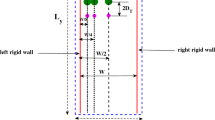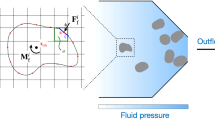Abstract
The evolution of pore structure caused by particle retention is a function of heterogeneity and nonlinear coupling of particle transport and fluid flow. Pore-scale modelling enables us to elucidate the role of various mechanisms controlling particle transport and deposition. This study incorporated the Eulerian–Lagrangian approach to investigate the spatial and temporal deposition of particles using a benchmark data set for an artificial column made of glass beads for validation. The velocity field and trajectory of particles were determined by solving the Navier–Stokes and momentum balance equations. When the mean diameter of particles is smaller than the image voxel size, several particles are required to occupy a pore voxel. Particles with low velocity that cannot escape from the adhesion forces of surfaces are considered as deposited. The solid volume fraction of pore voxels adjacent to solid voxels changes dynamically through particle deposition. The role of surface deposition and clogging mechanisms during various experimental simulation scenarios was analysed using an image-based technique. Mean injection velocity, particle size, surface adhesion forces, and surface roughness are considered as sensitivity parameters. The results show that the clogging mechanism was responsible for the structure permeability impairment rather than the surface deposition, when particle size and surface adhesion forces increased. However, the clogging mechanism did not affect permeability when surface roughness increased. Particle retention shows a maximum value around a critical velocity where the spatial particle retention switched from filter cake development to homogenous retention.
Article Highlights
-
A new CFD-based Eulerian–Lagrangian model for particle transport and retention at the pore scale is introduced.
-
The model can predict porosity/permeability changes of micro-CT scans of a filtration column experiment.
-
Injection velocity, particle size, surface adhesion forces, and roughness are sensitivity parameters.
-
The role of surface deposition and clogging effect are quantified using an image-based technique.












Similar content being viewed by others
References
Aliouchouche, N. (1997). Etude d'ecoulements par methode piv, Paris 11
Auset, M., Keller, A.A.: Pore-scale visualization of colloid straining and filtration in saturated porous media using micromodels: colloid straining and filtration. Water Resour. Res. (2006). https://doi.org/10.1029/2005WR004639
Babakhani, P., Bridge, J., Doong, R.-A., Phenrat, T.: Continuum-based models and concepts for the transport of nanoparticles in saturated porous media: a state-of-the-science review. Adv. Colloid Interface Sci. 246, 75–104 (2017)
Bekri, S., Thovert, J.-F., Adler, P.: Dissolution and deposition in fractures. Eng. Geol. 48, 283–308 (1997)
Bradford, S.A., Leij, F.J.: Modeling the transport and retention of polydispersed colloidal suspensions in porous media. Chem. Eng. Sci. 192, 972–980 (2018)
Chen, C., Packman, A.I., Gaillard, J.-F.: Pore-scale analysis of permeability reduction resulting from colloid deposition: colloid deposition reduces permeability. Geophys. Res. Letters 35(7), n/a-n/a (2008). https://doi.org/10.1029/2007GL033077
Chen, C., Lau, B.L., Gaillard, J.F., Packman, A.I.: Temporal evolution of pore geometry, fluid flow, and solute transport resulting from colloid deposition. Water Resour. Res. (2009). https://doi.org/10.1029/2008WR007252
Chen, X.-x, Cai, Q.-p, Zhong-han, Wu.: Experimental and theoretical study of coupled influence of flow velocity increment and particle size on particle retention and release in porous media. Water Sci. Eng. 10(3), 236–245 (2017). https://doi.org/10.1016/j.wse.2017.10.004
Constantin, P., Iyer, G.: A stochastic Lagrangian representation of the three-dimensional incompressible Navier-Stokes equations. Comm. Pure Appl Math.: J. Issued by the Courant Institute of Math. Sci. 61, 330–345 (2008)
Elrahmani, A., Al-Raoush, R.I., Abugazia, H., Seers, T.: Pore-scale simulation of fine particles migration in porous media using coupled CFD-DEM. Powder Technol. 398, 117130 (2022). https://doi.org/10.1016/j.powtec.2022.117130
Fernandez, X.R., Spelter, L.E., Nirschl, H.: Computational Fluid Dynamics (CFD) and Discrete Element Method (DEM) Applied to Centrifuges. Appl. Com. Fluid Dyn., 97 (2012)
Fu, X., Dutt, M., Bentham, A.C., Hancock, B.C., Cameron, R.E., Elliott, J.A.: Investigation of particle packing in model pharmaceutical powders using X-ray microtomography and discrete element method. Powder Technol. 167, 134–140 (2006)
Gao, B., Saiers, J.E., Ryan, J.: Pore-scale mechanisms of colloid deposition and mobilization during steady and transient flow through unsaturated granular media: mechanisms of Colloid Deposition and Mobilization. Water Res. Res. (2006). https://doi.org/10.1029/2005WR004233
Hamaker, H.C.: The London—van der Waals attraction between spherical particles. Physica 4(10), 1058–1072 (1937). https://doi.org/10.1016/S0031-8914(37)80203-7
Hilden, J., Rief, S., Plamas, B.: GrainGeo user guide GeoDict release 2022. https://www.math2market.de/fileadmin/UserGuide/GeoDict2022/GrainGeo2022.pdf (2021). Accessed 13 Jan 2022
Hommel, J., Coltman, E., Class, H.: Porosity–permeability relations for evolving pore space: a review with a focus on (bio-) geochemically altered porous media. Transp. Porous Media 124, 589–629 (2018)
Kermani, M.S., Jafari, S., Rahnama, M., Raoof, A.: Direct pore scale numerical simulation of colloid transport and retention. Part I: Fluid flow velocity, colloid size, and pore structure effects. Adv. Water Resour. 144, 103694 (2020)
Khan, H.J., Mirabolghasemi, M.S., Yang, H., Prodanović, M., DiCarlo, D.A., Balhoff, M.T.: Study of formation damage caused by retention of bi-dispersed particles using combined pore-scale simulations and particle flooding experiments. J. Pet. Sci. Eng. 158, 293–308 (2017)
Lawal, K.A., Vesovic, V., Boek, E.S.: Modeling permeability impairment in porous media due to asphaltene deposition under dynamic conditions. Energy Fuels 25, 5647–5659 (2011)
Lin, D., Liming, Hu., Bradford, S.A., Zhang, Xi., Lo, I.M.C.: Pore-network modeling of colloid transport and retention considering surface deposition, hydrodynamic bridging, and straining. J. Hydrol. 603, 127020 (2021a). https://doi.org/10.1016/j.jhydrol.2021.127020
Lin, D., Liming, Hu., Bradford, S., Zhang, Xi., Lo, I.M.C.: Simulation of Colloid Transport and Retention using a Pore‐Network Model with Roughness and Chemical Heterogeneity on Pore Surfaces. Water Resour. Res. (2021b). https://doi.org/10.1029/2020WR028571
Linden, S., Wiegmann, A., Hagen, H.: The LIR space partitioning system applied to the Stokes equations. Graph. Models 82, 58–66 (2015)
Mirabolghasemi, M., Prodanović, M., DiCarlo, D., Ji, H.: Prediction of empirical properties using direct pore-scale simulation of straining through 3D microtomography images of porous media. J. Hydrol. 529, 768–778 (2015)
Molnar, I.L., Johnson, W.P., Gerhard, J.I., Willson, C.S., O’carroll, D.M.: Predicting colloid transport through saturated porous media: A critical review. Water Resour. Res. 51, 6804–6845 (2015)
Mondal, S., Wu, C.-H., Sharma, M.M.: Coupled CFD-DEM simulation of hydrodynamic bridging at constrictions. Int. J. Multiphase Flow 84, 245–263 (2016)
Moslemipour, A., Sadeghnejad, S.: Dual-scale pore network reconstruction of vugular carbonates using multi-scale imaging techniques. Adv. Water Resour. 147, 103795 (2021)
Mourzenko, V., Békri, S., Thovert, J.-F., Adler, P.: Deposition in fractures. Chem. Eng. Commun. 148, 431–464 (1996)
Nishad, S., Al-Raoush, R.I., Alazaiza, M.Y. (2021) Release of colloids in saturated porous media under transient hydro-chemical conditions: A pore-scale study. Colloids Surf., A 614, 126188
Ohser, J., Mücklich, F.: Statistical analysis of microstructures in materials science. Prakt. Metallogr. 38, 538–539 (2001)
Ramachandran, V., Venkatesan, R., Tryggvason, G., Fogler, H.S.: Low Reynolds number interactions between colloidal particles near the entrance to a cylindrical pore. J. Colloid Interface Sci. 229, 311–322 (2000)
Rief, S., Latz, A., Wiegmann, A.: Computer simulation of air filtration including electric surface charges in three-dimensional fibrous micro structures. Filtration 6, 169–172 (2006)
Sadeghnejad, S., Enzmann, F., Kersten, M.: Digital rock physics, chemistry, and biology: challenges and prospects of pore-scale modelling approaches. Appl. Geochem., 105028 (2021)
Salles, J., Thovert, J., Adler, P.: Deposition in porous media and clogging. Chem. Eng. Sci. 48, 2839–2858 (1993)
Sell, K., Enzmann, F., Kersten, M., Spangenberg, E.: Microtomographic quantification of hydraulic clay mineral displacement effects during a CO2 sequestration experiment with saline aquifer sandstone. Environ. Sci. Technol. 47, 198–204 (2013)
Spivakovskaya, D., Heemink, A., Deleersnijder, E.: The backward Îto method for the Lagrangian simulation of transport processes with large space variations of the diffusivity. Ocean Sci. 3, 525–535 (2007)
Weber, A., Streit, A., Planas, B.: AddiDict user guide, GeoDict release 2022. https://www.math2market.de/UserGuide/data/AddiDict2021.pdf (2021). Accessed 13 Jan 2022
Yang, H., Balhoff, M.T.: Pore-network modeling of particle retention in porous media. AlChE J. 63, 3118–3131 (2017)
Zhang, Q., Raoof, A., Hassanizadeh, S.: Pore-Scale Study of Flow Rate on Colloid Attachment and Remobilization in a Saturated Micromodel. J. Environ. Quality 44, 1376–1383 (2015)
Zhao, W., Zhao, P., Tian, Y., Shen, C., Li, Z., Peng, P., Jin, C.: Investigation for Synergies of Ionic Strength and Flow Velocity on Colloidal-Sized Microplastic Transport and Deposition in Porous Media Using the Colloidal–AFM Probe. Langmuir 36, 6292–6303 (2020)
Zhou, Y., Chen, L., Gong, Y., Wang, S.: Pore-Scale Simulations of Particles Migration and Deposition in Porous Media Using LBM-DEM Coupling Method. Processes 9, 465 (2021)
Acknowledgements
The first author (S.S.) gratefully acknowledges financial support from the Alexander von Humboldt Foundation for visiting the Johannes Gutenberg University at Mainz, Germany. The authors also thank Dr C. Chen for providing more detailed information about the experimental results on the validation section, and Drs. A. Jacob and C. Hinz from Math2Market Co. for discussion on how to use python codes within the GeoDict environment. We also thank the anonymous reviewers for their careful reading and their many insightful comments and suggestions.
Funding
The authors have not disclosed any funding.
Author information
Authors and Affiliations
Corresponding author
Ethics declarations
Conflict of interest
The authors have not disclosed any competing interests.
Additional information
Publisher's Note
Springer Nature remains neutral with regard to jurisdictional claims in published maps and institutional affiliations.
Rights and permissions
Springer Nature or its licensor holds exclusive rights to this article under a publishing agreement with the author(s) or other rightsholder(s); author self-archiving of the accepted manuscript version of this article is solely governed by the terms of such publishing agreement and applicable law.
About this article
Cite this article
Sadeghnejad, S., Enzmann, F. & Kersten, M. Numerical Simulation of Particle Retention Mechanisms at the Sub-Pore Scale. Transp Porous Med 145, 127–151 (2022). https://doi.org/10.1007/s11242-022-01843-y
Received:
Accepted:
Published:
Issue Date:
DOI: https://doi.org/10.1007/s11242-022-01843-y




